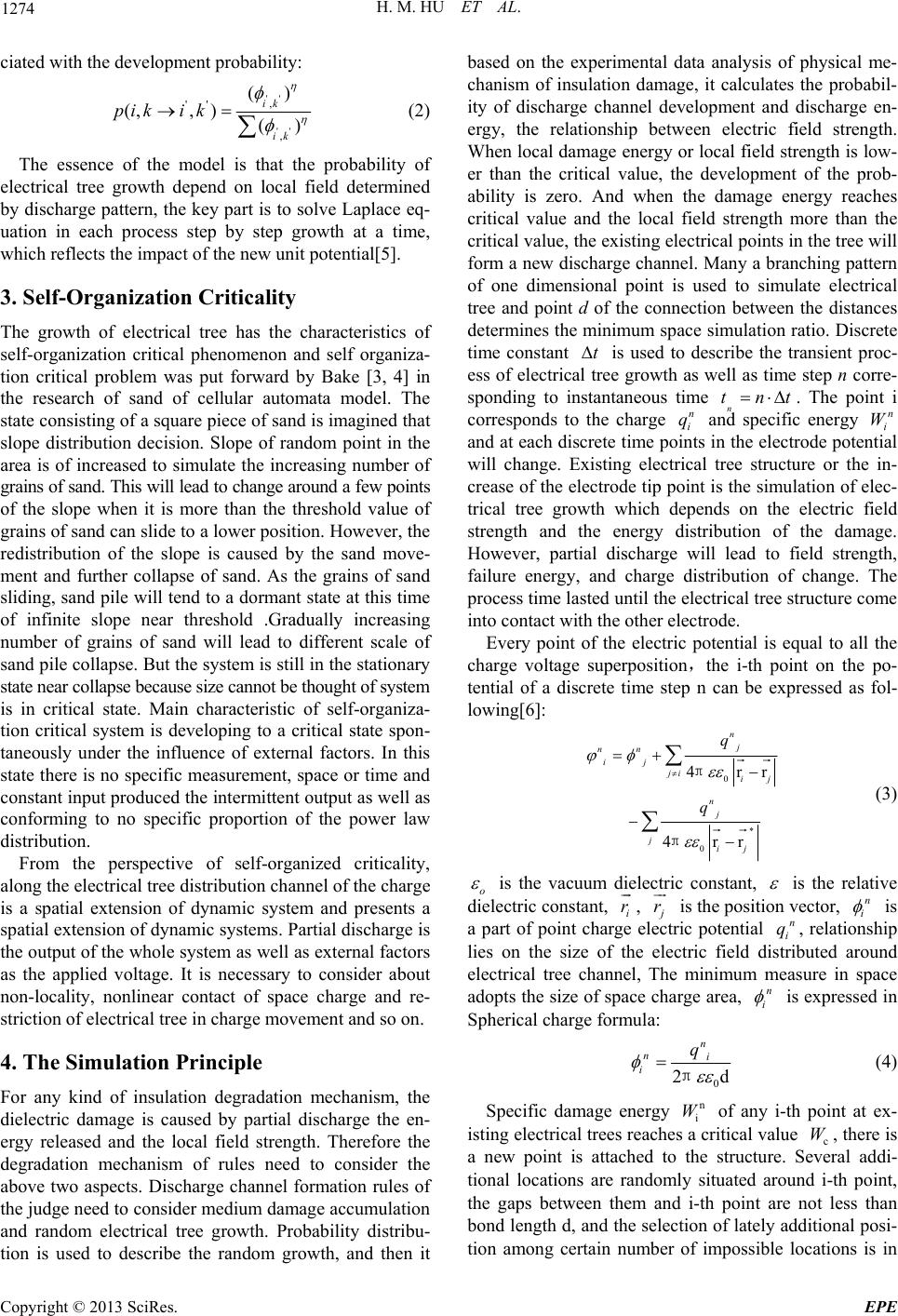
H. M. HU ET AL.
1274
ciated with the development probability:
''
''
,
''
,
()
(,, )()
ik
ik
piki k
(2)
The essence of the model is that the probability of
electrical tree growth depend on local field determined
by discharge pattern, the key part is to solve Laplace eq-
uation in each process step by step growth at a time,
which reflects the impact of the new unit potential[5].
3. Self-Organization Criticality
The growth of electrical tree has the characteristics of
self-organization critical phenomenon and self organiza-
tion critical problem was put forward by Bake [3, 4] in
the research of sand of cellular automata model. The
state consisting of a square piece of sand is imagined that
slope distribution decision. Slope of random point in the
area is of increased to simulate the increasing number of
grains of sand. This will lead to ch ange around a few points
of the slope when it is more than the threshold value of
grains of sand can slide to a lower position. However, the
redistribution of the slope is caused by the sand move-
ment and further collapse of sand. As the grains of sand
sliding, sand pile will tend to a dormant state at this time
of infinite slope near threshold .Gradually increasing
number of grains of sand will lead to different scale of
sand pile collapse. But th e system is still in the stationary
state near collapse because size cannot be thought of system
is in critical state. Main characteristic of self-organiza-
tion critical system is developing to a critical state spon-
taneously under the influence of external factors. In this
state there is no specific measurement, space or time and
constant input produced the intermittent output as well as
conforming to no specific proportion of the power law
distribution.
From the perspective of self-organized criticality,
along the electrical tree distribution channel of the charge
is a spatial extension of dynamic system and presents a
spatial extension of dynamic systems. Partial discharge is
the output of the whole system as well as external factors
as the applied voltage. It is necessary to consider about
non-locality, nonlinear contact of space charge and re-
striction of electrical tree in charge movement and so on.
4. The Simulation Principle
For any kind of insulation degradation mechanism, the
dielectric damage is caused by partial discharge the en-
ergy released and the local field strength. Therefore the
degradation mechanism of rules need to consider the
above two aspects. Discharge channel formation rules of
the judge need to consider medium damage accumulation
and random electrical tree growth. Probability distribu-
tion is used to describe the random growth, and then it
based on the experimental data analysis of physical me-
chanism of insulation damage, it calculates the probabil-
ity of discharge channel development and discharge en-
ergy, the relationship between electric field strength.
When local damage energy or local field strength is low-
er than the critical value, the development of the prob-
ability is zero. And when the damage energy reaches
critical value and the local field strength more than the
critical value, the existin g electrical p oints in the tree will
form a new discharge channel. Many a branching pattern
of one dimensional point is used to simulate electrical
tree and point d of the connection between the distances
determines the minimum space simulation ratio. Discrete
time constant t
is used to describe the transient proc-
ess of electrical tree growth as well as time step n corre-
sponding to instantaneous time n. The point i
corresponds to the charge and specific energy
and at each discrete time points in the electrode potential
will change. Existing electrical tree structure or the in-
crease of the electrode tip point is the simulation of elec-
trical tree growth which depends on the electric field
strength and the energy distribution of the damage.
However, partial discharge will lead to field strength,
failure energy, and charge distribution of change. The
process time lasted until the electrical tree structure come
into contact with the other electrode.
tnt
n
i
qn
i
W
Every point of the electric potential is equal to all the
charge voltage superposition,the i-th point on the po-
tential of a discrete time step n can be expressed as fol-
lowing[6]:
0
*
0
4rr
4rr
n
j
nn
ij
ji ij
n
j
jij
q
q
π
π
(3)
o
is the vacuum dielectric constant,
is the relative
dielectric constant, i
r
,
r
is the position vector, n
i
is
a part of point charge electric potential , relationship
lies on the size of the electric field distributed around
electrical tree channel, The minimum measure in space
adopts the size of space charge area,
n
i
q
n
i
is expressed in
Spherical charge formula:
0
2d
n
ni
i
q
π (4)
Specific damage energy of any i-th point at ex-
isting electrical trees reaches a critical value c, there is
a new point is attached to the structure. Several addi-
tional locations are randomly situated around i-th point,
the gaps between them and i-th point are not less than
bond length d, and the selection of lately add itional posi-
tion among certain number of impossible locations is in
n
i
WW
Copyright © 2013 SciRes. EPE